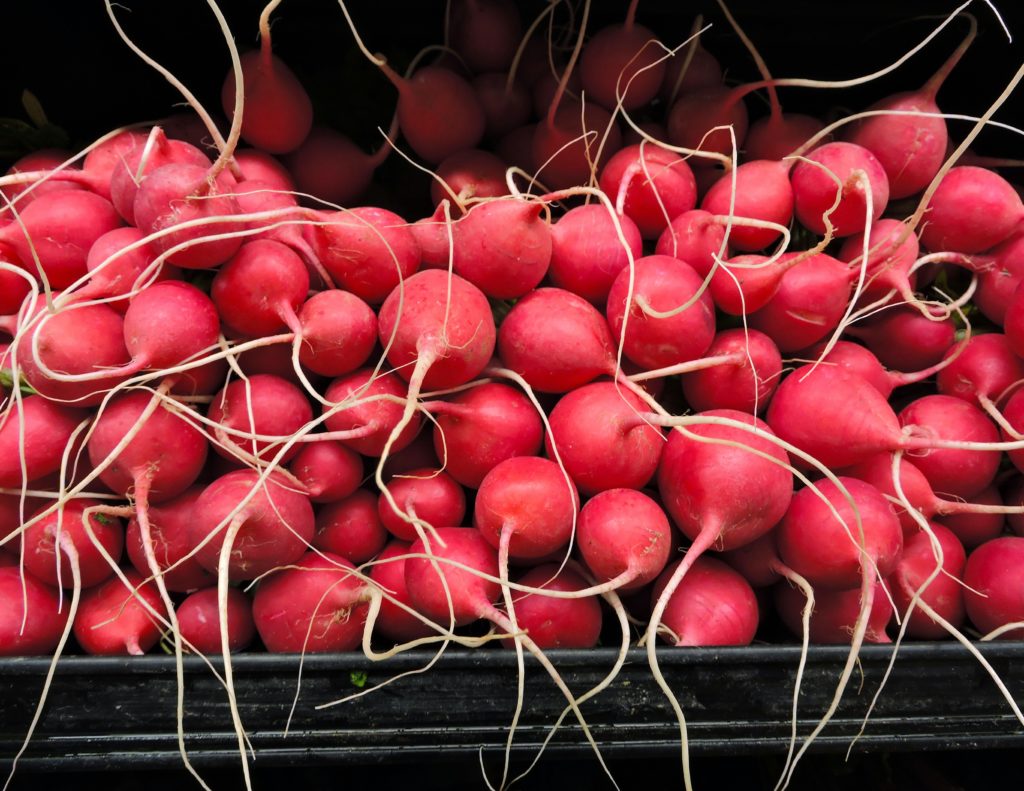
Radishes are one of the first joys of spring, bringing pops of red and green to the field, market, and kitchen. They are easy to maintain in the field and grow in as little as 3 weeks. Thousands of years ago, they began as cultivars in China before spreading West. Additionally, radishes were commonly eaten in Egypt long before the pyramids were built!
In the Garden
Like most of our veggie friends, radishes are in the Brassicaceae family.
Radishes are one of the early spring or late summer crops, so they are most often planted from early April-early May, and again in early August. However, they can grow all summer long, with varying textures and tastes. Since we eat their root, they need loosely textured soil so their roots do not become misshapen. They do best when direct seeded, then thinned to 1-3 inches once they germinate after 3-10 days. It is important to thin them before they grow their second set of leaves, because at that point they risk crowding out each other’s roots. These veggies are some of the fastest growing crops, usually ready to harvest after 22 days. You can tell if they are ready because their red roots will poke up above the soil, so you can tell what size they are.
Common spring varieties of french breakfast radishes include D’Avignon and Nelson, which have a spicy bite to them. The Sora variety does well even in the heat of midsummer, and is the cute red bulb we usually think of for radishes. For late summer planting and winter storage, daikon radishes are best, also known as “white carrots”. These take about 50 days until harvest, and only need watering on average once a week. They can last through the winter if stored in a cool spot, and make a nice addition to starchy dishes with other root vegetables.

In the Medicine Cabinet
Radishes have a high water content, so eating them raw makes for a crunchy and hydrating snack (especially if you’re out in the field)! They are also packed with nutrients – one cup of radishes contains 7% of our daily recommended fiber and potassium, while also rich in antioxidants and calcium. Try to find some with the tops on, because you can turn them into pesto, add them to salads, or even brew the leaves in hot water as a tea to soothe your stomach.
In the Kitchen
Red radishes, like sora, are great raw dipped in hummus or on salads. They are also delicious pickled for sandwiches! You can try a quick-pickle recipe that uses heat, or try a true pickling by allowing them to ferment. Both red and daikon radishes are great for a Korean radish salad, which is julienned radishes in a vinegar dressing. This is great to add to Bibimbap (Korean rice bowl) or a any salad.
Due to their zesty bite, french breakfast radishes are great sauteed in butter to balance out their spiciness. Add these to a salad or eat them mixed with other cooked veggies like carrots and peas topped with some fresh herbs like thyme. I like these best raw to get the full zesty experience!
Payge Lindow is the Farm Manager of Grow Jackson. She is a content creator for Taste the Local Difference.
